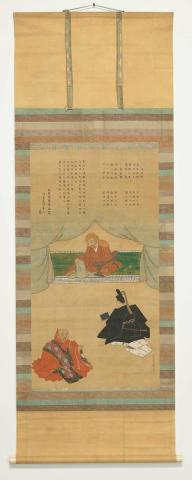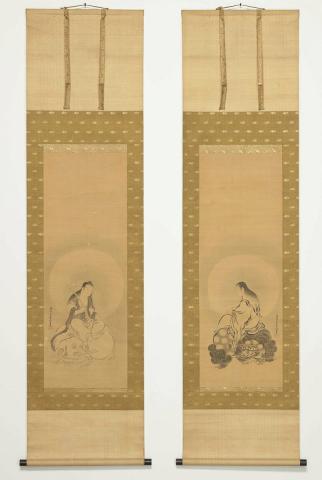The brush of Yukinobu
By Abigail Bernal
Artlines | 2-2024 | June 2024
Kiyohara Yukinobu was one of the few women of her era allowed to work as a professional artist. Acquired for the Collection with funds from the Henry and Amanda Bartlett Trust, four scrolls painted by Yukinobu provide a glimpse of the talent of a small group of known female artists from Japan’s Edo period, writes Abigail Bernal.
In seventeenth-century Japan, Kiyohara Yukinobu (1643–82) was one of the few women of the era allowed to paint as a profession. She often depicted mythological and historical female figures — including poets, goddesses and stories from the literary classic The Tale of Genji (written by Murasaki Shikibu, a female novelist and poet in the eleventh century) — as well as Buddhist icons and natural scenery, including bird-and-flower paintings. She is known for producing stunning screens as well as hanging scrolls, some inscribed with lines of poetry.
Within the history of Japanese art, it was common for painting traditions to be passed down through family generational lines. Yukinobu’s family was associated with the renowned Kanō school (founded in 1434CE). Her father was an artist and her mother’s uncle was the foremost Kanō painter, Kanō Tan’yū (1602–74). As a young girl, Yukinobu received encouragement from her father to learn from other painters at the school. She lived in Kyoto for most of her life and, like her mother and grandmother before her, married a Tan’yū pupil, continuing the strong familial bonds characteristic of the Kanō school. Her works are signed ‘Brush of Yukinobu, Daughter of the Kiyohara (Kanō) Clan’. Yukinobu was highly regarded and received acknowledgment and recognition during her life, which was tragically cut short when she died aged just 39.
The scroll Cherry blossom and long tailed chicken captures her refined brushwork and bold style, illustrating a classic motif of birds and trees in full bloom. Perched on a slender branch, a black-faced bird with white feathers spreads its wings, its gracefully arched long tail feathers tipped with red. The composition, framed by lush brocade, shows a poetic use of depth and negative space and a sensibility to native subjects. The transience of the blossoms as well as their seasonal appearance after winter makes them symbolic of life and new growth.
The same considered use of negative space is apparent in the images of the two bodhisvattas in the paired scrolls Fugen Bosatsu and Monzyu Bosastsu. Predominantly in sepia colour, each figure holds an object (one reads a sutra, while the other has a sword). The accompanying animals help to identify them as Fugen Bosatsu (Samantabhadra Bodhisattva) and Fugen Monzyu (Monju) (Manjusri Bodhisattva) — brother princes born during the lifetime of the historical Buddha, who were often depicted together and generally accompanying the Buddha Sakyamuni. Fugen Bosatsu is always shown on a white elephant, while Fugen Monzyu sits atop a lion. The figures are related to Mahayana Buddhism, which spread from India to Japan around the ninth century.
Less is known about the scroll Sankasei no zo, though it shares many similarities with depictions from The Tale of Genji by other Kanō school artists. Yukinobu created several scrolls depicting scenes from the classic story.1 In this work, seated men wearing vibrantly coloured clothing are arranged in an elegant triangular composition. Yukinobu’s deployment of the folding curtain or canopy, on which text or perhaps verse is inscribed, is an unusual and charming element that frames the scene.
Complementing works in the QAGOMA Collection by Buddhist nun, poet, potter and calligrapher Ōtagaki Rengetsu (1791–1875), these recently acquired scrolls by Kiyohara Yukinobu provide a glimpse of the talent of a small group of known female artists from Japan’s Edo period, who were able to circumnavigate social regulations and defined gender roles.2
Abigail Bernal is Associate Curator, Asian Art, QAGOMA.
Endnotes
- A beautiful scroll titled Murasaki Shikibu by Yukinobu depicts the authoress of The Tale of Genji writing her famed novel. It is held in the collection of the New Orleans Museum of Art, Louisiana.
- The recent exhibition ‘Her Brush – Japanese Women Artists from the Fong-Johnstone Collection’ (13 November 2022 – 16 July 2023) at the Denver Art Museum, Colorado, highlighted the work of more than ten remarkable female artists of the Edo and Meiji periods. For the digital catalogue, see https://her-brush.denartmus.org, accessed 22 February 2024


